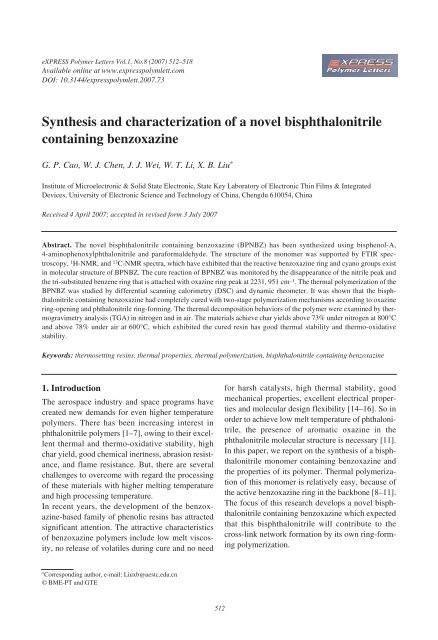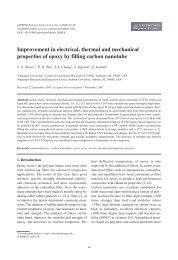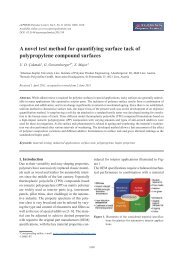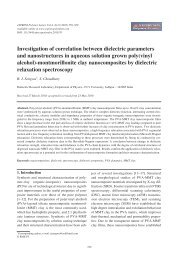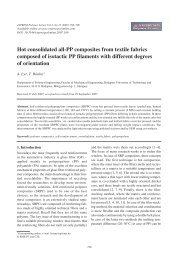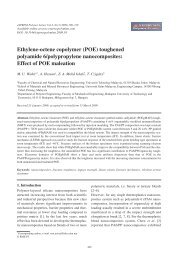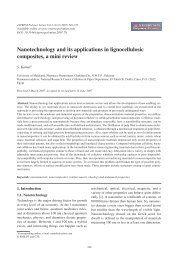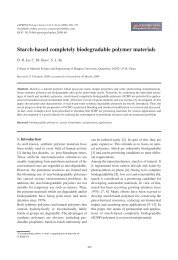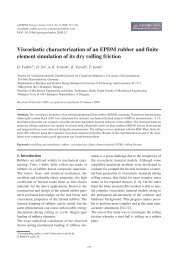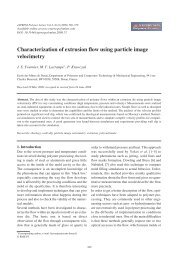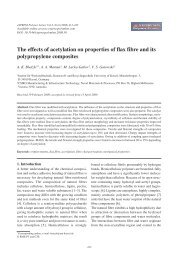Synthesis and characterization of a novel bisphthalonitrile ...
Synthesis and characterization of a novel bisphthalonitrile ...
Synthesis and characterization of a novel bisphthalonitrile ...
You also want an ePaper? Increase the reach of your titles
YUMPU automatically turns print PDFs into web optimized ePapers that Google loves.
eXPRESS Polymer Letters Vol.1, No.8 (2007) 512–518<br />
Available online at www.expresspolymlett.com<br />
DOI: 10.3144/expresspolymlett.2007.73<br />
<strong>Synthesis</strong> <strong>and</strong> <strong>characterization</strong> <strong>of</strong> a <strong>novel</strong> <strong>bisphthalonitrile</strong><br />
containing benzoxazine<br />
G. P. Cao, W. J. Chen, J. J. Wei, W. T. Li, X. B. Liu *<br />
Institute <strong>of</strong> Microelectronic & Solid State Electronic, State Key Laboratory <strong>of</strong> Electronic Thin Films & Integrated<br />
Devices, University <strong>of</strong> Electronic Science <strong>and</strong> Technology <strong>of</strong> China, Chengdu 610054, China<br />
Received 4 April 2007; accepted in revised form 3 July 2007<br />
Abstract. The <strong>novel</strong> <strong>bisphthalonitrile</strong> containing benzoxazine (BPNBZ) has been synthesized using bisphenol-A,<br />
4-aminophenoxylphthalonitrile <strong>and</strong> paraformaldehyde. The structure <strong>of</strong> the monomer was supported by FTIR spectroscopy,<br />
1 H-NMR, <strong>and</strong> 13 C-NMR spectra, which have exhibited that the reactive benzoxazine ring <strong>and</strong> cyano groups exist<br />
in molecular structure <strong>of</strong> BPNBZ. The cure reaction <strong>of</strong> BPNBZ was monitored by the disappearance <strong>of</strong> the nitrile peak <strong>and</strong><br />
the tri-substituted benzene ring that is attached with oxazine ring peak at 2231, 951 cm –1 . The thermal polymerization <strong>of</strong> the<br />
BPNBZ was studied by differential scanning calorimetry (DSC) <strong>and</strong> dynamic rheometer. It was shown that the <strong>bisphthalonitrile</strong><br />
containing benzoxazine had completely cured with two-stage polymerization mechanisms according to oxazine<br />
ring-opening <strong>and</strong> phthalonitrile ring-forming. The thermal decomposition behaviors <strong>of</strong> the polymer were examined by thermogravimetry<br />
analysis (TGA) in nitrogen <strong>and</strong> in air. The materials achieve char yields above 73% under nitrogen at 800°C<br />
<strong>and</strong> above 78% under air at 600°C, which exhibited the cured resin has good thermal stability <strong>and</strong> thermo-oxidative<br />
stability.<br />
Keywords: thermosetting resins, thermal properties, thermal polymerization, <strong>bisphthalonitrile</strong> containing benzoxazine<br />
1. Introduction<br />
The aerospace industry <strong>and</strong> space programs have<br />
created new dem<strong>and</strong>s for even higher temperature<br />
polymers. There has been increasing interest in<br />
phthalonitrile polymers [1–7], owing to their excellent<br />
thermal <strong>and</strong> thermo-oxidative stability, high<br />
char yield, good chemical inertness, abrasion resistance,<br />
<strong>and</strong> flame resistance. But, there are several<br />
challenges to overcome with regard the processing<br />
<strong>of</strong> these materials with higher melting temperature<br />
<strong>and</strong> high processing temperature.<br />
In recent years, the development <strong>of</strong> the benzoxazine-based<br />
family <strong>of</strong> phenolic resins has attracted<br />
significant attention. The attractive characteristics<br />
<strong>of</strong> benzoxazine polymers include low melt viscosity,<br />
no release <strong>of</strong> volatiles during cure <strong>and</strong> no need<br />
for harsh catalysts, high thermal stability, good<br />
mechanical properties, excellent electrical properties<br />
<strong>and</strong> molecular design flexibility [14–16]. So in<br />
order to achieve low melt temperature <strong>of</strong> phthalonitrile,<br />
the presence <strong>of</strong> aromatic oxazine in the<br />
phthalonitrile molecular structure is necessary [11].<br />
In this paper, we report on the synthesis <strong>of</strong> a <strong>bisphthalonitrile</strong><br />
monomer containing benzoxazine <strong>and</strong><br />
the properties <strong>of</strong> its polymer. Thermal polymerization<br />
<strong>of</strong> this monomer is relatively easy, because <strong>of</strong><br />
the active benzoxazine ring in the backbone [8–11].<br />
The focus <strong>of</strong> this research develops a <strong>novel</strong> <strong>bisphthalonitrile</strong><br />
containing benzoxazine which expected<br />
that this <strong>bisphthalonitrile</strong> will contribute to the<br />
cross-link network formation by its own ring-forming<br />
polymerization.<br />
*Corresponding author, e-mail: Liuxb@uestc.edu.cn<br />
© BME-PT <strong>and</strong> GTE<br />
512
Cao et al. – eXPRESS Polymer Letters Vol.1, No.8 (2007) 512–518<br />
2. Experimental<br />
2.1. Materials<br />
All chemicals were used as received. Paraformaldehyde<br />
(CP), toluene (99.5%), N-N-dimethylformamide<br />
(DMF, 99.5%), potassium carbonate<br />
(99%), <strong>and</strong> 1,4-dioxane (99%) were obtained from<br />
Tianjin BODI Chemicals. 4-nitrophthalonitrile<br />
(99%) was obtained from Alpha Chemical (Dezhou)<br />
Co. Ltd. 4-Aminophenol (CP) was obtained form<br />
Sinopharm Chemical Reagent Co., Ltd. Bisphenol-<br />
A was obtained form Tianjin Guangfu Fine Chemical<br />
Research Institute. All solvents used were<br />
certified A.C.S grade <strong>and</strong> used as received.<br />
2.2. <strong>Synthesis</strong><br />
2.2.1. <strong>Synthesis</strong> <strong>of</strong><br />
4-aminophenoxylphthalonitrile<br />
To a 250 ml three neck round-bottom flask<br />
equipped with a mechanical stirrer, refluxing condenser,<br />
<strong>and</strong> 4-nitrophthlonitrile (34.6 g, 0.2 mol),<br />
4-Aminophenol (21.8 g, 0.2 mol), potassium carbonate<br />
(30 g,), <strong>and</strong> DMF (120 ml) were added. The<br />
reaction mixture refluxed at 85°C for 6 h. After 6 h,<br />
the mixture was precipitated into dilute NaOH<br />
(1 mol/l) using an additional funnel with slow addition<br />
rate. The brown precipitate was filtered <strong>and</strong><br />
dried in vacuum oven at 70°C shown in Figure 1.<br />
Melting point (T m ):134°C; typical IR data:<br />
3457 cm –1 (–NH 2 ), 2231 cm –1 (–CN), 1247 cm –1<br />
(stretch, C–O–C), 1493 cm –1 (1, 2 <strong>and</strong> 4 substitution<br />
<strong>of</strong> benzene ring), 830 cm –1 (1, 4 substitution <strong>of</strong><br />
benzene ring).<br />
2.2.2. <strong>Synthesis</strong> <strong>of</strong> the <strong>novel</strong> <strong>bisphthalonitrile</strong><br />
containing benzoxazine (BPNBZ)<br />
To a 250 ml three neck round-bottom flask<br />
equipped with a mechanical stirrer, refluxing condenser,<br />
the 4-aminophenoxylphthalonitrile (23.4 g,<br />
0.1 mol), bisphenol-A (11.4 g, 0.05 mol), <strong>and</strong><br />
Paraformaldehyde (6 g, 0.2 mol) were dissolved in<br />
40 ml <strong>of</strong> 1,4-dioxane <strong>and</strong> 20 ml <strong>of</strong> toluene <strong>and</strong> the<br />
reaction mixture refluxed at 110°C for 5 h. Then,<br />
the solvent was evaporated using a vacuum pump,<br />
<strong>and</strong> the crude product was obtained. Then, the<br />
crude product was dissolved in DMF <strong>and</strong> precipitated<br />
into the dilute NaOH (1 mol/l). The brown<br />
precipitate was filtered through a glass filter under<br />
vacuum <strong>and</strong> dried in vacuum oven at 70°C, <strong>and</strong> the<br />
purified <strong>bisphthalonitrile</strong> containing benzoxazine<br />
(BPNBZ) was obtained, shown in Figure 1 [11].<br />
The typical IR characteristics data: 2231 cm –1<br />
(–CN), 1503, 951 cm –1 [12, 13] (tri-substituted<br />
benzene ring that is attached with oxazine ring),<br />
1247, 1032 cm –1 (stretch, C–O–C) [12, 13], 1086,<br />
830 cm –1 (stretch C–N–C) [12], 1420 cm –1 (CH 2<br />
antisymmetric stretch); 1 H-NMR (400 MHz, CDCl 3 )<br />
δ (ppm): 1.621–1.627 (CH 3 ), 4.615–4.629 (CH 2 );<br />
5.350 (N–CH 2 –O), 6.740–6.745 (N–Ar–H), 6.762–<br />
6.907 (ortho to N–Ar–). 13 C-NMR (400 MHz,<br />
CDCl 3 ) δ (ppm): 31.05 (CH 3 ), 41.83 (C(CH 3 ) 2 ),<br />
51.03 (Ar–CH 2 –N), 79.10 (N–CH 2 –O), 115.46<br />
(Ar–C≡N), 121.01 (C–CH 2 –N), 143.44 (C 11 ),<br />
146.94 (C 8 ), 162.35 (C 7 ).<br />
2.2.3. Thermal polymerization <strong>of</strong> the monomer<br />
The BPNBZ monomer could be polymerized by<br />
heating. The conditions <strong>of</strong> the BPNBZ polymeriza-<br />
Figure 1. The synthesis <strong>of</strong> the <strong>bisphthalonitrile</strong> containing benzoxazine<br />
513
Cao et al. – eXPRESS Polymer Letters Vol.1, No.8 (2007) 512–518<br />
Table 1. The cured schedule <strong>of</strong> the prepolymer <strong>and</strong> polymer<br />
Sample<br />
Time <strong>and</strong> temperature<br />
b<br />
160°C-12h<br />
c<br />
160°C-12h 180°C-12h<br />
d<br />
160°C-12h 180°C-12h 200°C-8h<br />
e 160°C-12h 180°C-12h 200°C-8h 220°C-6h<br />
f 160°C-12h 180°C-12h 200°C-8h 220°C-6h 250°C-6h<br />
tion were listed in Table 1. The cured samples were<br />
heated at 160°C for12 h, 180°C for12 h, 200°C for<br />
8 h, 220°C for 6 h <strong>and</strong> 250°C for 6 h consecutively.<br />
A hard shiny blue-black solid was obtained.<br />
2.2.4. Characterizations<br />
The structure <strong>of</strong> monomer <strong>and</strong> resins were characterized<br />
in KBr pellets at Shimadzu FTIR8400S.<br />
The resins with different cured extent were prepared<br />
in DSC by heating from 50 to 180 (b), 200<br />
(c), 220 (d), 250 (e) <strong>and</strong> 275°C (f) at a heating rate<br />
10°C/min respectively.<br />
1 H-NMR <strong>and</strong> 13 C-NMR spectra were obtained<br />
using a Bruker AV400 nuclear magnetic resonance<br />
spectrometer (NMR) at a proton frequency <strong>of</strong><br />
400 MHz <strong>and</strong> the corresponding carbon frequency.<br />
The solvent is CDCl 3 .<br />
The thermal behaviors <strong>of</strong> monomer <strong>and</strong> resins were<br />
investigated by the differential scanning calorimetry<br />
(DSC) <strong>and</strong> thermogravimetry analysis (TGA).<br />
The differential scanning calorimetry (DSC) was<br />
performed on TA Instruments Modulated DSC-<br />
Q100 with a heating rate <strong>of</strong> 10°C/min <strong>and</strong> a nitrogen<br />
flow rate <strong>of</strong> 50 ml/min. All samples were<br />
crimped in hermetic aluminum pans with lids. The<br />
thermogravimetry analysis (TGA) was performed<br />
on the TA instruments Q50 thermogravimetric analyzer<br />
with a heating rate <strong>of</strong> 20°C/min <strong>and</strong> a nitrogen<br />
flow rate <strong>of</strong> 50 ml/min or an air flow rate <strong>of</strong><br />
50 ml/min.<br />
The dynamic rheological measurements were carried<br />
out using TA Instruments AR-G2 Oscillatory<br />
Rheometer with a heating rate <strong>of</strong> 10°C/min <strong>and</strong> the<br />
frequency <strong>of</strong> 10 Hz under air atmosphere.<br />
3. Results <strong>and</strong> discussion<br />
3.1. Characterization <strong>of</strong> structure <strong>of</strong> BPNBZ<br />
<strong>and</strong> resin<br />
The structure <strong>of</strong> BPNBZ as shown in Figure 1 was<br />
verified by 1 H-NMR <strong>and</strong> 13 C-NMR spectroscopy<br />
<strong>and</strong> the corresponding spectrum was shown in Figure<br />
2 <strong>and</strong> 3. In 1 H-NMR, resonances appearing at<br />
4.63 <strong>and</strong> 5.35 ppm are assigned to the methylene<br />
protons in the oxazine ring <strong>of</strong> BPNBZ [13]. The<br />
prominent resonance at 1.621 <strong>and</strong> 1.627 ppm in the<br />
aromatic frequency corresponds to methyl <strong>of</strong> the<br />
monomer. Furthermore, the structure <strong>of</strong> the<br />
monomer is confirmed by using 13 C-NMR <strong>and</strong> the<br />
corresponding chemical shifts are shown in Figure<br />
3, according to chemical shift values, the peak<br />
at 79.5 ppm indicates the characteristic resonance<br />
<strong>of</strong> –CH 2 – in oxazine ring, <strong>and</strong> the peak at 115 ppm<br />
is the characteristic resonance <strong>of</strong> –CN. Along with<br />
the excellent agreement between the calculated <strong>and</strong><br />
observed data <strong>of</strong> the elemental analysis for the purified<br />
sample, it shows that the targeted compounds<br />
were obtained in high purity [13].<br />
The FTIR spectrum <strong>of</strong> BENBZ is shown in Figure<br />
4a. The appearance <strong>of</strong> –CN at 2231 cm –1 <strong>and</strong><br />
tri-substituted benzene ring that is attached with<br />
oxazine ring at 1503, <strong>and</strong> 951 cm –1 can be<br />
observed. The b<strong>and</strong> at 1247 cm –1 is assigned to the<br />
C–O–C antisymmertic, while the b<strong>and</strong> at<br />
1032 cm –1 is assigned to the C–O–C symmetric<br />
stretch [12, 13]. The antisymmertic <strong>and</strong> symmetric<br />
stretch <strong>of</strong> the C–N–C is observed at 1086,<br />
830 cm –1 . These results show a <strong>novel</strong> <strong>bisphthalonitrile</strong><br />
containing benzoxazine could be synthesized<br />
by this technique.<br />
The FTIR spectra <strong>of</strong> resins are shown in Figure 4.<br />
The peaks at 951, 1503, 2231, 1360, 1521, 1640<br />
<strong>and</strong> 3280 cm –1 show changes in intensity as a function<br />
<strong>of</strong> cure temperature. To observe the thermal<br />
polymerization <strong>and</strong> curing reaction mechanisms <strong>of</strong><br />
BPNBZ, we use the non-isothermal polymerization<br />
techniques by DSC instrument scanning to schedule<br />
program, so as to explain the way <strong>of</strong> thermal<br />
polymerization <strong>and</strong> the structures <strong>of</strong> crosskicked<br />
networks. From these results, the changes <strong>of</strong> all<br />
characteristic peaks are no apparent when scanning<br />
from 50 to 180°C using non-isothermal polymerization<br />
reactions by DSC instrument (Figure 4b),<br />
the intensity <strong>of</strong> the peak at 951 <strong>and</strong> 1503 cm –1<br />
decreased faintly after scanning to 200°C shown in<br />
Figure 4c. At the same time, the peak attributed<br />
phenolic hydroxyl group at 3300–3400 cm –1 was<br />
enhanced, suggesting the polymerization reaction<br />
<strong>of</strong> oxazine ring-opening appears (Figure 4d). After<br />
scanning to 250°C, the b<strong>and</strong> <strong>of</strong> tri-substituted benzene<br />
ring that is attached with oxazine ring disap-<br />
514
Cao et al. – eXPRESS Polymer Letters Vol.1, No.8 (2007) 512–518<br />
Figure 2. 1 H-NMR spectrum <strong>of</strong> BPNBZ in CDCl 3<br />
Figure 3. 13 C-NMR spectrum <strong>of</strong> BPNBZ in CDCl 3<br />
515
Cao et al. – eXPRESS Polymer Letters Vol.1, No.8 (2007) 512–518<br />
mechanisms may be operational in the cure reactions<br />
<strong>of</strong> <strong>bisphthalonitrile</strong> containing benzoxazine.<br />
Figure 4. FTIR spectra <strong>of</strong> the monomer (a),<br />
partially cured resin (b), (c), (d), (e) <strong>and</strong> (f)<br />
pears at 1503 cm –1 <strong>and</strong> the prominent b<strong>and</strong> <strong>of</strong> tetrasubstituted<br />
appears at 1500 cm –1 , suggesting benzoxazine<br />
polymerization via ring-opening is<br />
complete. According to the decrease <strong>of</strong> intensity <strong>of</strong><br />
the peak at 2231 cm –1 <strong>and</strong> the appearance <strong>of</strong> new<br />
peaks at 1521, 1360 1637 (–C=N–) <strong>and</strong> 3275 cm –1<br />
(N–H), which are contributed to the characteristic<br />
absorptions <strong>of</strong> triazinne <strong>and</strong> phthalocyaine, suggest<br />
the polymerization reaction <strong>of</strong> –CN groups has<br />
happened, as shown in Figure 4e. The Figure 5<br />
indicates the typical FTIR spectra <strong>of</strong> the ring-forming<br />
proceedings <strong>of</strong> –CN groups, the reactions are<br />
enhanced with the elevating <strong>of</strong> temperature. After<br />
scanning to 275°C, the peak <strong>of</strong> –CN at 2231 cm –1<br />
decreases clearly, shown in Figure 4f. These spectral<br />
observations suggest that multiple reaction<br />
3.2. DSC <strong>and</strong> TGA analysis<br />
The thermal polymerization reactions <strong>of</strong> the<br />
monomer were studied by DSC as shown in Figure<br />
6a. The DSC trace has two well resolved polymerization<br />
peaks. The first polymerization peak at<br />
the temperature range from 170 to 265°C is mainly<br />
attributed to the oxazine ring-opening polymerization,<br />
<strong>and</strong> the second peak at the temperature range<br />
from 265 to 300°C owes to the <strong>bisphthalonitrile</strong><br />
ring-forming polymerization. This result was supported<br />
by the FTIR spectra results. From Figure 6,<br />
the cured extent <strong>of</strong> resin increased as a function <strong>of</strong><br />
cure temperature <strong>and</strong> time, the peaks decreased<br />
with the increase <strong>of</strong> time <strong>and</strong> temperature. The<br />
resins with different cured extent are shown in<br />
Table 1, we found that the first peak had eliminated<br />
after curing at 200°C for 8 h (Figure 6d), <strong>and</strong> from<br />
Figure 6e <strong>and</strong> f, the second peak had eliminated<br />
basically after curing at 220°C for 6 h <strong>and</strong> 250°C<br />
for 5 h. There is a peak at the temperature range<br />
from 325 to 360°C, the temperature 325°C is postcure<br />
temperature <strong>and</strong> the 360°C is the initial<br />
decomposition temperature, which can be support<br />
by the TGA results. As these results, it means that<br />
the <strong>bisphthalonitrile</strong> containing benzoxazine had<br />
completely cured with two-stage polymerization<br />
mechanisms according to oxazine ring-opening <strong>and</strong><br />
phthalonitrile ring-forming.<br />
The TGA curves <strong>of</strong> the polymers as shown in Figure<br />
7. The initial decomposition temperatures (T id )<br />
<strong>of</strong> the polymer under nitrogen <strong>and</strong> air are about<br />
Figure 5. FTIR spectra <strong>of</strong> the pre-cured resins<br />
Figure 6. The DSC curves <strong>of</strong> the monomer (a) <strong>and</strong> the<br />
pre-cured resin (b), (c), (d), (e) <strong>and</strong> (f)<br />
516
Cao et al. – eXPRESS Polymer Letters Vol.1, No.8 (2007) 512–518<br />
Figure 7. The TGA curves <strong>of</strong> the polymer a) in N 2, b) in<br />
air<br />
343.38 <strong>and</strong> 354.06°C, respectively. The temperatures<br />
at weight loss 5 <strong>and</strong> 10% in nitrogen atmosphere<br />
are 437.50 <strong>and</strong> 504.59°C <strong>and</strong> in air<br />
atmosphere are 434.63 <strong>and</strong> 504.29°C, respectively.<br />
The char yield at 800°C under nitrogen is 73.65%<br />
<strong>and</strong> at 600°C under air is 78.66%. In Table 2, the<br />
thermal properties <strong>of</strong> BPNBZ are summarized <strong>and</strong><br />
compared to other phthalonitrile. The thermal properties<br />
<strong>of</strong> BPNBZ under nitrogen are as well as or<br />
decrease slightly than the other two monomers, but<br />
there is a significant improvement <strong>of</strong> the BPNBZ<br />
thermal properties under air than the other two.<br />
Therefore, the BPNBZ can be used for making<br />
heat-resistance high performance composites.<br />
3.3. The rheological behavior<br />
Figure 8 is relationship between rheological behaviors<br />
<strong>and</strong> temperature under curing process <strong>of</strong> <strong>bisphthalonitrile</strong><br />
containing benzoxazine. Two transitions<br />
<strong>of</strong> G’ appear from 200 to 300°C <strong>and</strong> two cross<br />
Figure 8. The rheological behaviors <strong>of</strong> the BPNBZ under<br />
non-isothermal curing<br />
points <strong>of</strong> G’ <strong>and</strong> G” were observed at 242.7 <strong>and</strong><br />
276.1°C, respectively. The G” has two apparent<br />
peaks. The first peak ranges from 200.9 to 242.7°C,<br />
<strong>and</strong> the second peak ranges from 242.7 to 276.1°C.<br />
The Delta curve appears two sharp peaks; the temperature<br />
<strong>of</strong> peak top is 230.7 <strong>and</strong> 276.1°C respectively.<br />
As these results, the former suggests primary<br />
polymerization <strong>of</strong> oxazine ring-opening, <strong>and</strong><br />
the later suggests the <strong>bisphthalonitrile</strong> polymerizations<br />
<strong>of</strong> nitrile groups. So, it means that the <strong>bisphthalonitrile</strong><br />
containing benzoxazine had completely<br />
cured with two-stage polymerization mechanisms<br />
which are consistent with the DSC results.<br />
4. Conclusions<br />
The <strong>novel</strong> <strong>bisphthalonitrile</strong> containing benzoxazine<br />
(BPNBZ) has been synthesized using bisphenol-A,<br />
4-aminophenoxylphthalonitrile <strong>and</strong> paraformaldehyde.<br />
The structure <strong>of</strong> the monomer was supported<br />
by FTIR spectroscopy, 1 H-NMR, <strong>and</strong> 13 C-NMR<br />
Table 2. summary <strong>of</strong> TGA results<br />
Monomer<br />
Nitrogen<br />
Air<br />
T 5% T 10% Char yield [wt%] 800°C T 5% T 10% Char yield [wt%] 600°C<br />
437 505 73 434 504 78<br />
414 505 73 378 420 0<br />
544 596 80 390 450 75<br />
517
Cao et al. – eXPRESS Polymer Letters Vol.1, No.8 (2007) 512–518<br />
spectra, which have exhibited that the reactive benzoxazine<br />
ring <strong>and</strong> cyano groups exist in molecular<br />
structure <strong>of</strong> BPNBZ. The cure reaction mechanism<br />
<strong>of</strong> BPNBZ was monitored by the disappearance <strong>of</strong><br />
the nitrile peak <strong>and</strong> the tri-substituted benzene ring<br />
that is attached with oxazine ring peak at 2231,<br />
951 cm –1 . The <strong>bisphthalonitrile</strong> containing benzoxazine<br />
polymer possesses excellent thermal stability,<br />
thermal-oxidation stability <strong>and</strong> high char yield in<br />
nitrogen <strong>and</strong> air. The materials char yields achieved<br />
73% at 800°C under nitrogen <strong>and</strong> 78% at 600°C<br />
under air. The temperatures at weight loss 5% <strong>and</strong><br />
10% under air are 434.63 <strong>and</strong> 509.29°C, respectively.<br />
According to the observations <strong>of</strong> thermal<br />
polymerization by DSC <strong>and</strong> dynamical rheology,<br />
the curing process <strong>of</strong> <strong>bisphthalonitrile</strong> containing<br />
benzoxazine has two stages polymerization mechanisms<br />
according to oxazine ring-opening <strong>and</strong><br />
phthalonitrile ring-forming. The cured extent is a<br />
function <strong>of</strong> temperature <strong>and</strong> time. It can be used as<br />
a matrix <strong>of</strong> advanced composites.<br />
Acknowledgements<br />
This project was sponsored by ‘Excellent Talents Program’<br />
<strong>of</strong> University <strong>of</strong> Electronic Science <strong>and</strong> Technology <strong>of</strong><br />
China.<br />
References<br />
[1] Keller T. M., Dominguez D. D.: High temperature<br />
resorcinol-based phthalonitrile polymer. Polymer, 46,<br />
4614–4618 (2005).<br />
[2] Warzel M. L., Keller T. M.: Tensile <strong>and</strong> fracture properties<br />
<strong>of</strong> a phthalonitrile polymer. Polymer, 34, 663–<br />
666 (1993).<br />
[3] Dominguez D. D., Jones H. N., Keller T. M.: The<br />
effect <strong>of</strong> curing additive on the mechanical properties<br />
<strong>of</strong> phthalonitrile-carbon fiber composites. Polymer<br />
Composites, 25, 554–561 (2004).<br />
[4] Sastri S. B., Armistead J. P., Keller T. M.: Phthalonitrile-carbon<br />
fiber composites. Polymer Composites,<br />
17, 816–822 (1996).<br />
[5] Zhang J., Liu X., Wen H., Xie M., Cai X.: Investigation<br />
<strong>of</strong> the properties <strong>of</strong> phthalocyanine resin containing<br />
bismaleimide groups. Polymer International, 42,<br />
363–366 (1997).<br />
[6] Dominguez D. D., Keller T. M.: Properties <strong>of</strong><br />
phthalonitrile monomer blends <strong>and</strong> thermosetting<br />
phthalonitrile copolymers. Polymer, 48, 91–97 (2007).<br />
[7] Laskoski M., Dominguez D. D., Keller T. M.: <strong>Synthesis</strong><br />
<strong>and</strong> properties <strong>of</strong> a bisphenol A based phthalonitrile<br />
resin. Journal <strong>of</strong> Polymer Science Part A: Polymer<br />
Chemistry, 43, 4136–4143 (2005).<br />
[8] Kim H. J., Brunoyska Z. B., Ishida H.: Molecular<br />
<strong>characterization</strong> <strong>of</strong> the polymerization <strong>of</strong> acetylenefunctional<br />
benzoxazine resins. Polymer, 40, 1815–<br />
1822 (1999).<br />
[9] Rimdusit S., Ishida H.: Development <strong>of</strong> new class <strong>of</strong><br />
electronic packaging materials based on ternary systems<br />
<strong>of</strong> benzoxazine, epoxy, <strong>and</strong> phenolic resins.<br />
Polymer, 41, 7941–1949 (2000).<br />
[10] Takeichi T., Guo Y., Agag T.: <strong>Synthesis</strong> <strong>and</strong> <strong>characterization</strong><br />
<strong>of</strong> poly (urethane-benzoxazine) films as<br />
<strong>novel</strong> type <strong>of</strong> polyurethane/phenolic resin composites.<br />
Journal <strong>of</strong> Polymer Science Part A: Polymer Chemistry,<br />
38, 4165–4176 (2000).<br />
[11] Brunovska Z., Lyon R., Ishida H., Riga A., Collins R.:<br />
Thermal properities <strong>of</strong> phthalonitrile functional polybenzoxazines.<br />
Thermochimica Acta, 357–358, 195–<br />
203 (2000).<br />
[12] Dunkers J., Ishida H.: Vibrational assignments <strong>of</strong> 3-<br />
alkyl-2, 4-dihydro-1, 3-benzoxazines. Spectrochimia<br />
Acta, Part A: Molecular Spectroscopy, 51, 1061–1074<br />
(1995).<br />
[13] Ishida H., Ohba S.: <strong>Synthesis</strong> <strong>and</strong> <strong>characterization</strong> <strong>of</strong><br />
maleimide <strong>and</strong> norbornene functionalized benzoxazines.<br />
Polymer, 46, 5588–5595 (2005).<br />
[14] Salamone J. C.: Polymeric materials encyclopedia.<br />
New York, CRC Press (1996).<br />
[15] Ishida H. J., Allen D. J.: Physical <strong>and</strong> mechanical<br />
<strong>characterization</strong> <strong>of</strong> near-zero shrinkage polybenzoxazine.<br />
Polymer Science, Part B: Polymer Physics, 34,<br />
1019–1030 (1996).<br />
[16] Ishida H., Low H. Y.: A study on the volumetric<br />
expansion <strong>of</strong> benzoxazine-based phenolic resin.<br />
Macromolecules, 30, 1099–1106 (1997).<br />
518


